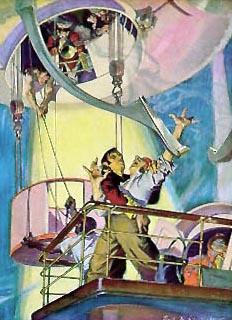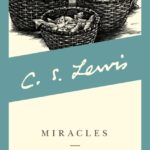The Success Of Fantasy By The Masters
 Is fantasy “weird” and therefore a type of story only to be enjoyed by a niche group of readers? I, and others here at Spec Faith, have adamantly and repeatedly said no. (Most recently I did so in “Is Christian Speculative Fiction Weird?” at A Christian Worldview of Fiction.)
Is fantasy “weird” and therefore a type of story only to be enjoyed by a niche group of readers? I, and others here at Spec Faith, have adamantly and repeatedly said no. (Most recently I did so in “Is Christian Speculative Fiction Weird?” at A Christian Worldview of Fiction.)
From time to time, I’ve justified my beliefs by pointing to the wide popularity of C. S. Lewis’s Narnia stories and, to a greater extent, J. R. R. Tolkien’s Middle Earth stories. How can we explain “non-fantasy” readers reading and loving these books? How can we explain their continued popularity more than fifty years after publication?
I think Professor Michael D.C. Drout, an instructor at Wheaton College, identifies what Tolkien accomplished and few others have duplicated:
Although he did not know it at the time, Tolkien’s famous first line [in The Hobbit], “In a hole in the ground there lived a hobbit,” began the development of the key concept that would cause the success of The Lord of the Rings: Tolkien had created a character who could mediate between the medieval stories he loved so much and the world of his twentieth-century, middle-class readers. (excerpt from EXPLORING FANTASY LITERATURE: Course Guide)
According to Dr. Drout, Tolkien, and I would argue Lewis, created a bridge for contemporary readers to step into the realm of the fantastic. These writers tied their magical, mystical worlds to the world readers knew and recognized.
Interestingly, they did so in vastly different ways. Lewis used the now familiar device of a portal from the known world into the magical world. Characters living in familiar settings and circumstances were transported to a land where animals talked and mythical beings existed,
Tolkien on the other hand, created a character who was so believably and recognizably a middle class westerner, that readers related, though he lived Elsewhere, and was himself unique. The genius of Tolkien was that Bilbo (and later Frodo and the other hobbits) was different from us in ways that reminded us of … us.
He lived in his comfy hole in the ground, in the Shire tucked away from the rest of the world. How easy, then, for him to involve himself with his own cares and ignore the dangers of the greater world. He also loved his ease. His excesses were no more than others of his kind–six meals and a good pipe. But they were of paramount concern to him and to forgo enjoying them required great sacrifice from his perspective.
Hobbits, then, especially those in the lead roles, were easy to underestimate because they were so ordinary–like so many readers who would like to believe they might rise to the occasion if the need occurred, but would much rather continue in as much comfort and self-concern as possible.
Regardless of the method, the result of Lewis and Tolkien’s mediation was to usher readers from one world to the other, as if they, too, were entering into the mystical and magical.
Why haven’t successive fantasies, which apparently attempt the same mediation between the now and the imagined, found the same acceptance by readers? I suggest two main reasons.
First, many of the later fantasy worlds feel warmed over. They are by now as familiar as the contemporary world, and entering them holds no surprises.
In converse, I think some writers try so hard to create a world that is wholly other, they abandon the attempt to mediate between the imagined world and the one in which their readers live. In other words, these writers are leaving their readers behind.
In some cases, if the reader is brave enough or trusting enough, he might forge ahead and discover a world as rich and enticing as Narnia or Middle Earth. But will large numbers of readers take that leap of faith? I don’t think so. Thus, a niche is born.
If fantasy is to engage the public at large, I believe writers need to discover ways to mediate between the real and the imagined. But isn’t that similar to what the Christian should be doing as part of his witness–to shine the light on truths about this world and that of the hereafter?
The presentation of an eternal future with God, as truthful as it is, is hard for a starving man to grasp or to care about. Believers, then, must show our culture that God is not far off or interested only in someday. We must show that He bridged the gap.
Christ Himself, of course, is the perfect Mediator, between God and Man. His incarnation is the perfect example of ushering mankind–readers, if you will–into the transcendent world. He did so by modeling both Tolkien and Lewis’s methods. In a reverse of the typical portal story, He arrived from Heaven into this world, but He did so as a perfectly relatable Person, much like Tolkien’s characters.
In conclusion, we fantasy writers today need to discover how to mediate between our unique mystical, magical worlds and twenty-first century readers. Can we adapt Tolkien’s method or Lewis’s? Of course. In doing so we are simply following Christ’s true-to-life model. But here’s the key: the more successful we are, the less weird our stories will seem.
Who are other writers that you believe have successfully mediated between readers and their imagined world? How did they pull it off? Have they broken out of the niche of “weird” as a result?










































OOH! Clever observation. Let me think about how that plays out in some of my favorite stories…
Doctor Who: Just about every companion is having a normal-ish day when they meet the Doctor. Rose is working at a shop, Martha is doing rounds at a hospital, and Amy is a little girl afraid of monsters. Okay, Donna’s getting married, but the details of getting back to the wedding are very much emphasised.
A Wrinkle in Time has Meg as a stubborn girl whose father is missing—a scenario even more common today than when the book was written.
Auralia’s Thread series: I’d be hard put to define how this book eases the transition. Maybe by just having ordinary-talking characters find the main character. They talk like you’d expect old, slightly less than respectable men to talk.
This theory also works for the popularity of Harry Potter–though longtime fantasy readers can point to worldbuilding problems that you could drive a truck through, the greater portion of the world that does not read fantasy found Harry Potter midway between our world and the other world. (It also helped that Rowling used tropes from the Sports Story, and especially rejuvenated the Boarding School Story, once immensely popular, though not so much in the past fifty years.)
Great example, Sherwood. Rowling did indeed create a thoroughly relatable boy in a “normal” world, and her fantasy realm has reminders of the normal everywhere–celebrating holidays, school books and bullies, and sports, as you mentioned. Yes, she used the everyday to pull in readers and bridge the gap to the magical.
I thought of Stephen Lawhead–even did a post about it on my own site. 🙂
Becky
First author who comes to mind is Rachel Starr Thomson! The first chapter of Worlds Unseen begins with a town of familiar sights: an orphanage, a train, a courteous passer-by. When Maggie gets home (to her shabby but sturdy house with peeling paint on the shutters), she sits in an armchair and has a cup of tea. Then a visitor arrives, bringing with him tales of extraordinary truths. The prologue also begins in a more-or-less familiar setting: a stone cottage with a bubbling pot and a woman working at embroidery.
I think you’ve hit on a great reason why Narnia and Middle Earth are so appealing and so enduring! This is an aspect of world-creating that I had never fully considered, so thank you for posting!
Blessings,
Literaturelady
I did enjoy the beginning of Worlds Unseen for those exact reasons. It felt Dickens-like, and the introduction of magic was welcome and delicious. 🙂
Lit Lady, your comment made me think of Jill Williamson’s latest book The New Recruit. That one has an everyday character who joins an imaginative organization. The fantasy isn’t so much other worldly as it is supernatural. But the point is, Jill pulls readers into pretend through the gateway of the normal, so that when the supernatural pops into the story, it’s only a small step to accept it.
By the way, that’s a book I highly recommend.
Becky
[…] in the Bright Empires series by Stephen Lawhead, the CSFF Blog Tour’s October feature. In “The Success Of Fantasy By The Masters” I take a look at why Narnia and J.R.R. Tolkien’s Middle Earth became popular, even with […]
I think that’s one reason I enjoy modern/urban fantasy so much. It meets me where I am and takes me to fantastic places that might be right around the corner.
Think about fairytales. When they were first told, they were modern fantasy. “Don’t go out in the woods or the witch will get you!” It was where people lived. Even “once upon a time” stories were set in a world similar to those of the people telling the story.
Modern/urban fantasy takes fairytales and updates them. In our world, would you be more afraid to walk through the woods at night, or through the ghettos of your home town? What if those scary places are where the witches, werewolves and cursed princes now lurk?
Great point, Kessie. I think you’re right–books in an urban setting are more immediately relatable to people in today’s society because that’s what we know so well.
Also a true observation about fairytales. Once they were contemporary.
Becky
I’ve been learning to appreciate modern/urban fantasy more, although I have yet to read the Dresden Files. 😉 You may be right that modern/urban fantasy are the modern equivalent of fairy tales.
However, I don’t think modern/urbany fantasy can replace high/epic fantasy. There were fairy tales that may have been “contemporary” in the Middle Ages, but there was also always mythology. Maybe the distinctions between high fantasy and modern fantasy have always existed, in the difference between folk fairy tales and epic mythological sagas. We need both.
Sure, of course we need both. But I’ve noticed that a lot of juvie and YA fantasy is modern/urban, perhaps because that’s more accessible for kids. Harry Potter, Fablehaven, Lightning Thief, Ashtown Burials, and so on. Even Hunger Games had a modernish setting. There’s a lot more epic fantasy aimed at adults.
Going back to Rebecca’s main point, linking the familiar and the supernatural is an important part of fantasy. I’ve grown up reading contemporary spec fic, not even knowing what it was (Heinlein’s and Bradbury’s juvie fiction is fantastic stuff). I happen to like contemporary settings because I’m a Tolkien snob. All epic fantasy copies from him at some point, and I despise reading ripoffs.